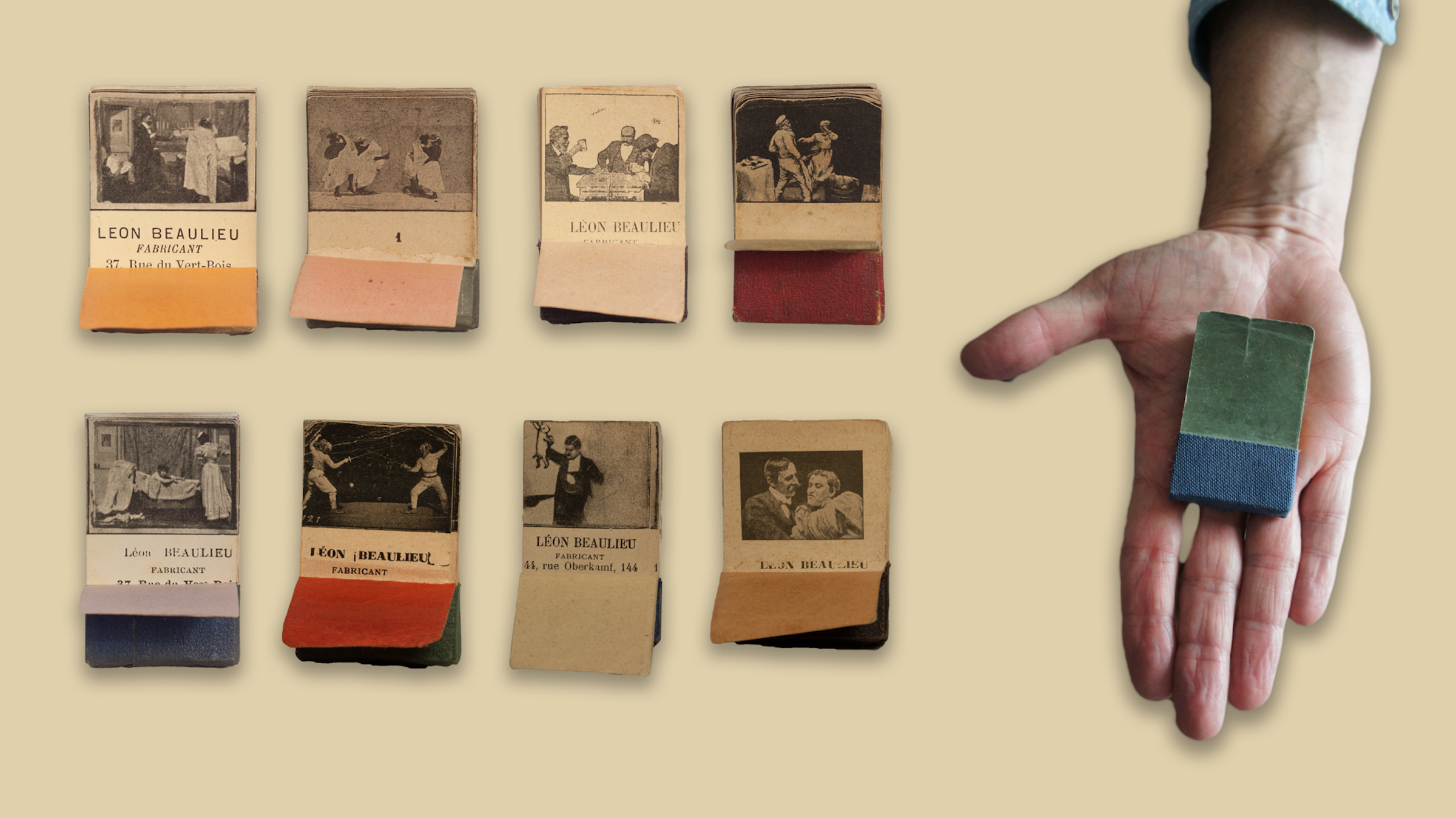This feature was published in conjunction with the Amazing Tales from the Archives presentation by Thierry Lecointe and Robert Byrne at SFSFF 2019
LOST FILMS OF GEORGES MÉLIÈS DISCOVERED IN FIN DE SIÈCLE FLIPBOOKS
From peep shows to gifs, moving images have proliferated as novelties inside and outside the movie theater since the invention of motion picture photography. In America, the most well-known of the early inventions is the Mutoscope, a single-viewer wooden cabinet that creates the illusion of movement with the crank of handle. But it was the simple and portable flipbook that put this illusion in the palm of a hand more than a century before the smartphone came along.
The earliest flipbooks predate motion pictures by nearly thirty years and books derived from motion pictures came hand-in-hand with the advent of projected films and examples were produced in the United States, England, Germany, Spain, and France as early as 1896. In France, the Lumières developed the Kinora, a viewer that cycled through bound images made from their films, while the Gaumont company used the traditional booklet form. However, recent research into Parisian manufacturer Léon Beaulieu has yielded some astonishing revelations.
Frenchman Léon Beaulieu manufactured his first flipbooks in late 1896, with his most productive period occurring late 1897 to early 1898. On March 9, 1898, he registered a patent for a “mechanical stripper,” a simple device for browsing what he called “pocket cinematographs.” Over his brief years of operation (1896–1901), his business was fairly itinerant (to say the least). Addresses printed on his flipbooks and confirmed in Parisian business directories name five different business locations in as many years. The last address, 257, rue Saint-Denis in Paris, was his location on February 22, 1901, at the time of his death at age forty-three.
Only bare traces of documentation exist to provide what little is known of Beaulieu’s life. He had brown hair, gray eyes, and stood just over five-feet tall but, physical characteristics aside, his truculent personality is what stands out as his most defining feature. His 1880 induction papers for military service at age twenty indicate that he had already lost both parents. He could read and write but only attained a primary level of education. While in the military, he was imprisoned for two years for “insults and threats to a superior outside the service” and was denied a certificate of good conduct when he entered the reserves in 1885. He later served another two months for assault, followed by two years in prison for fraud, and then two more months for another assault. In August 1896, the army discharged him because of asthma and obesity. The final entry in his penal record shows that on January 29, 1901, just weeks before his death, he was fined a hundred francs for an unspecified morals misdemeanor.
Independent researcher Thierry Lecointe first came across Beaulieu and his flipbooks in July 2013. A German collector had launched a crowdsourcing project hoping to identify an incomplete flipbook that he thought might depict Georges Méliès 1896 film, The Arrival of a Train at Vincennes Station. Though no conclusions were drawn at the time, Lecointe took up the hunt with the conviction that the book’s images provided sufficient evidence (such as the inscription on the engine, locomotive and wagon markings, and the angle of the shadows) to accurately identify the station and the producer of the original film. Ultimately, he reached the conclusion that the book was very likely derived from frames of Georges Méliès’s Arrival of a Train at Joinville (Méliès catalog number 35). Lecointe then came to the tantalizing realization that there could be others out there.
Lecointe’s search led him to the French collector and historian Pascal Fouché, whose collection of more than ten thousand flipbooks (catalogued at flipbook.info) includes a corpus of twenty-four flipbooks manufactured by Beaulieu which, based on exhaustive research, is considered to be complete.
Of the twenty-four Beaulieu books in Fouché’s collection, two use sequences of well-known films by Edison and Gaumont but others are from films no longer thought to exist. All the books in his collection appropriate images from motion picture films produced 1896–1897. Through a meticulous comparison of décor and other compositional elements in extant films, Lecointe has definitively attributed seven fragments from the films of Georges Méliès and thirteen others that possibly originate from Méliès films but cannot be identified with absolute certainty.
While most flipbooks came in a consistent format, Beaulieu published his books in a variety of dimensions and in lengths that ranged from 32 to 121 folios. By disassembling one of the books, Lecointe determined how Beaulieu manufactured his. He printed images side by side using a halftone photoengraving technique (similar to newspaper photography printing) and then cut the individual pages and bound them into the small finished books of varying sizes (11×11, 7×12, 9×10, etc.).
Since October 2017, Lecointe and moving image restorer Byrne have collaborated with Pascal Fouché to reanimate these delicate treasures. Photographer Onno Petersen devised an innovative mount that allowed each page to be photographed without risk to the pages or their fragile binding. In the final tally, some 2,346 photograms have been photographed, allowing glimpses of some of the very earliest motion pictures to complete their long journey back to the movie screen.
A SAMPLING OF FLIPBOOK FILMS
Miss de Vère (Gigue Anglaise) Attributed to George Méliès, Star Film catalog no. 45 (1896). No film copies known to survive.
Arrivée d’un Train (Gare de Joinville) Attributed to George Méliès, Star Film catalog no. 35 (1896).
David Devant Attributed to George Méliès, Star Film catalog no. 101 (1897).
Une Nuit Terrible Possible alternate version. Positively attributed to George Méliès, Star Film catalog no. 26 (1896).
Moulin Rouge: Quadrille Positively attributed to Gaumont, catalog no. 3 (1896).

